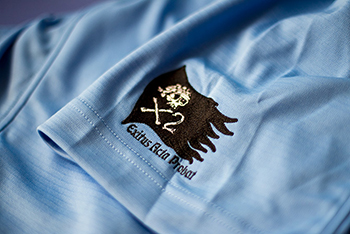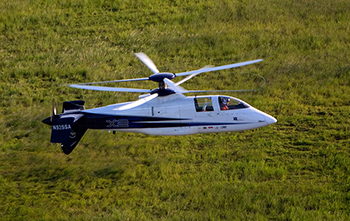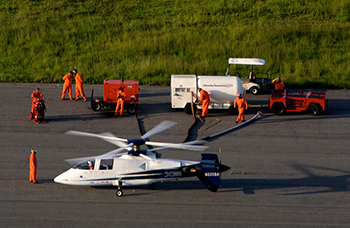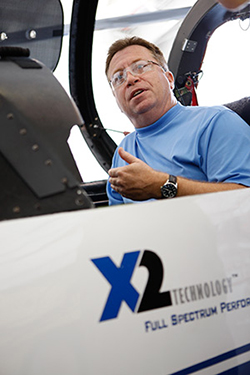Swamp Pirates
The Sikorsky X2 team is honored for speeding
Ingenuity, $50 million of Sikorsky’s money, six years, stolen parts, endless bananas, a foot, and 12 trashed egos combined to push helicopter technology past a barrier that begins around 150 to 160 knots true airspeed, a barrier that had stood for 60 years. Sikorsky’s X2 exceeded that speed by 100 knots, kicked past the barrier by a propeller on its tail designed like one used in the Reno air races. It all started because someone told Sikorsky engineer Steve Weiner it couldn’t be done. Make a note: Never say “can’t” to Steve.
 His team built the single-seat X2 technology demonstrator, tested it in subzero temperatures of New York, and broke the record in the steamy haze that Floridians call air. Sikorsky owns Schweitzer Aircraft in Horseheads, New York, where the X2 was built, and bases its Sikorsky Innovations group in the wetlands northwest of Palm Beach Gardens, Florida. Mosquitoes and swamp fleas are constant companions, and alligators slide under workers’ cars for a snooze. Check before driving.
His team built the single-seat X2 technology demonstrator, tested it in subzero temperatures of New York, and broke the record in the steamy haze that Floridians call air. Sikorsky owns Schweitzer Aircraft in Horseheads, New York, where the X2 was built, and bases its Sikorsky Innovations group in the wetlands northwest of Palm Beach Gardens, Florida. Mosquitoes and swamp fleas are constant companions, and alligators slide under workers’ cars for a snooze. Check before driving.
At the time of the X2’s final planned flight on July 14, it had gone 253 knots true airspeed in level flight (in 2010), 263 in a one-degree descent, and might have gone 280 to 290 knots with an aerodynamic fairing between the two rotors (now a new barrier emerges—300 knots).
The goal was 250 knots, and Sikorsky decided to stop the tests—which achieved success in only 17 flights, and won the 2010 Collier trophy—and put the technology to practical use in an upcoming Raider helicopter for the U.S. Army. Intended cruise speed, especially with external weapons mounted, is 210 to 220 knots. The Raider happens to be the perfect size for an executive transport helicopter.
Beware of X2 guys
 Many in the team joke that most of the X2 parts were stolen from helicopters sitting idle in dusty corners of Sikorsky hangars—like returning to a parking spot to see your car on blocks and the wheels gone. They painted a pirate flag on the X2 and proudly wore it on T-shirts. Yet, Sikorsky gives the impression of a by-the-book company, and it is more likely that proper paperwork passed hands when a part went missing, if only as a courtesy.
Many in the team joke that most of the X2 parts were stolen from helicopters sitting idle in dusty corners of Sikorsky hangars—like returning to a parking spot to see your car on blocks and the wheels gone. They painted a pirate flag on the X2 and proudly wore it on T-shirts. Yet, Sikorsky gives the impression of a by-the-book company, and it is more likely that proper paperwork passed hands when a part went missing, if only as a courtesy.
That can’t be said of the X2’s landing gear, where there is greater uncertainty between theft and proper requisition. It’s possible that the manager of the Sikorsky boneyard is reading here for the first time that his Cessna Skymaster, once used as a chase plane, is missing its gear. The struts were remade by the X2 team out of titanium to handle the 6,100-pound load of the X2. You just can’t steal good parts these days.
That’s 2,000 pounds per wheel, as Weiner knows, because the aircraft accidentally rolled over his foot one day. He appeared to be walking normally during the final flight of the X2. “It took a third of a finger, a foot, and 12 egos,” an X2 manager told Weiner after the last flight. The “finger” refers to an X2 employee who years ago caught a steel-blade fan as it fell, losing the tip of his finger.
For the next 18 months the helicopter will tour the country, including AOPA Summit, before retiring to the Udvar-Hazy annex of the National Air and Space Museum.
Good boy, have a banana
You won’t find pilot Kevin Bredenbeck’s name in the press release announcing the final flight, because Bredenbeck wants the focus on the team. When that team painted “Kevin Bredenbeck, Chief Test Pilot, 007” on the side of the X2, noting his role as only the seventh Sikorsky chief test pilot, Bredenbeck wanted it removed. He relented when he realized it was more important for team morale that it stay.
Bredenbeck has a habit of eating a banana as his breakfast and was branded a “space monkey” by the team. After major accomplishments during the 17 flights, the team gave him a plastic banana with the achievement written on the side. “I hate to say how simple it is to fly this aircraft, because I like to think I’m a special kind of person,” Bredenbeck joked. “But let’s just say any monkey that you feed a banana to can fly this aircraft.”
He needed an assistant monkey on the first flight of the X2, when the aircraft proved a handful. In pilot parlance, it was “hot”—that is, twitchy. Step one on the flight test card was to pick it up (lift off). “Step two was to land, and I said, ‘I think we need to wait for the landing. I don’t think it is going to be too good.’”
So he flew it around for a while, acting as sort of an airplane whisperer, getting to know the aircraft’s bad habits. When he came back he had it figured out, so he landed twice, but there was an ulterior motive.
An engineer had taken a photo of his off-centerline landing after an earlier flight and posted it on the Internet before Bredenbeck was out of the aircraft. It was a conventional helicopter used to test X2 flight control systems—and the engineer knew he faced razzing for the problem in the yaw control system. His point was that while his software needed improvement, so did Bredenbeck’s landings. On that first landing in the X2, after literally a shaky start, Bredenbeck returned to the landing pad and landed off the centerline. Remembering the engineer with the camera, and knowing he had the aircraft figured out, he lifted off to the consternation of the flight test director, circled around, landed on the line, and radioed, “Bryan, you can come out and take a picture now.”
Solving the stability problem in the fly-by-wire system was the key to the X2’s success.
An earlier try
 The X2 wasn’t Sikorsky’s first attempt to reach 250 knots and solve the advancing-blade problem. If a helicopter blade moves at 300 knots at a hover, and then you move forward at 200 knots, the advancing blade gains greater lift because it has a relative speed of 500 knots. The retreating blade has a relative speed of 100 knots and much less lift—an imbalance that would cause the helicopter to roll. All helicopters compensate for this problem, but none are able to compensate at X2 speeds.
The X2 wasn’t Sikorsky’s first attempt to reach 250 knots and solve the advancing-blade problem. If a helicopter blade moves at 300 knots at a hover, and then you move forward at 200 knots, the advancing blade gains greater lift because it has a relative speed of 500 knots. The retreating blade has a relative speed of 100 knots and much less lift—an imbalance that would cause the helicopter to roll. All helicopters compensate for this problem, but none are able to compensate at X2 speeds.
There was an attempt to reach 250 knots with two test models designated XH–59A in the late 1970s and early 1980s. A speed of 245 knots true airspeed was reached—a huge accomplishment—but stability was a serious problem. It took two pilots operating nine levers to keep the thing flying, and it had four heavy turbine engines. The X2 has one engine and one pilot; the technology is scalable to nearly all of Sikorsky’s models, including twin-engine models. It now appears that the first use of the technology will appear in a candidate for a military aerial scout replacement. Sikorsky is building a model of it at its own expense, shared by its suppliers, the Raider. (Steve Engebretson, director of the Armed Aerial Scout Program, said he expects the military contract will be worth $10 billion to $12 billion.) All the lessons learned during the XH–59A program contributed to the success of the X2.
The XH–59A, like the X2, had twin rotors going in opposite directions, but the computerized stability would have to wait decades for gains in computer technology. When a single-rotor helicopter reaches high speeds, the retreating rotor blade (going backwards from nose to tail) can no longer generate enough lift, and the helicopter begins to roll. The pitch of the retreating blade can be increased by a computer, but only so far before the blade has an aerodynamic stall. With twin rotors going in opposite directions, one blade is always advancing on each side of the aircraft.
One of the XH–59A aircraft sits in a boneyard at NASA Ames Research Center, Moffett Field, California, minus an engine now on loan. (The research was a joint U.S. Army/NASA/Sikorsky effort.) The aircraft was sent to Ames after a hard landing and became a wind tunnel model. Its rotors are in a box under the tunnel. The other aircraft that did most of the flight testing is on outdoor display at Fort Rucker, Alabama.
“You can see the lineage back to those folks, because they really set the foundation for this technology,” said Jim Kagdis, program manager for Advanced Programs. “We hit some hurdles back in the ’80s with the technology, but the aircraft that Steve has developed and Kevin has flown, has allowed us to take advantage of things like fly-by-wire, things like composites, things like a really good engine and prop system all rigged together. Looking forward it is the Raider. That Raider is the perfect size for an executive transport aircraft, and then growing up to a Blackhawk. We’re giving our customers another tool in their tool kit.”
Space Balls
The X2 seemed stuck at 181 knots on its quest for speed, until Weiner and his associates determined the horizontal tail surfaces needed to be increased by seven square feet. Stabilizers were added to the lower fin, and the race resumed.
T-shirts emerged with the speed goals listed on the back; beside most goals is a golden banana. Here’s the list: 125 knots Bon Jovi Speed (halfway to 250, or Bon Jovi’s lyrics, “We’re halfway there,” from Livin’ On a Prayer); 150 knots Sub-Light Speed; 180 knots Light Speed; 200 knots Ridiculous Speed; 250 knots Ludicrous Speed; 250+ knots (represented by a black banana, because it hadn’t been achieved when the T-shirt was made) Plaid Speed.
“Sub-light, Light, Ridiculous, and Plaid, all came from the [1987] movie Space Balls,” said X2 program manager Steve Cizewski. “There’s a scene in the movie where they kept accelerating at these speeds. So, 150 knots is a standard helicopter speed; 180 knots is really the top of any kind of rotorcraft speed. At 200 we were faster than any rotorcraft speed. We were into fixed-wing speeds, so that became Ridiculous. And who goes 250 knots in a helicopter? That’s gotta be ludicrous. And we did go 253 knots. In the movie, Space Balls, when you go over Ludicrous speed you go to Plaid speed because you leave a whole trail of plaid behind the spacecraft.”
Don’t say “can’t”
 “This project started in the hallway with someone who was trying to convince me that helicopters were now commodities—that there was nothing left to do, performance-wise—and we should just be focusing on cost reduction,” said Steve Weiner, director of Engineering Sciences and chief engineer for the X2 program.
“This project started in the hallway with someone who was trying to convince me that helicopters were now commodities—that there was nothing left to do, performance-wise—and we should just be focusing on cost reduction,” said Steve Weiner, director of Engineering Sciences and chief engineer for the X2 program.
“We took that good old concept [XH–59A] that we knew could work with the current technologies, and we ran it up through the CEO of UTC [United Technologies] until we got approval to do the program. The rest is sitting out there on the runway, so….” That’s Weiner’s way of saying I told you so.
The advantages of the X2 are still in the discovery process. Weiner noted that air ambulances will now need only 30 minutes of the Golden Hour—the time when medical treatment of injuries is most effective—to get patients to the hospital. Here are some other advantages discussed by various team members:
It can fly backward at 60 knots, getting out of range of a sniper while continuing to aim the helicopter’s guns at the threat. Most helicopters fly backward at only 10 or 15 knots in daily practice, although higher speeds are possible. It can hover nose low, hanging on its prop, again to keep guns on a target, or hover nose high if the threat is from above.
It doesn’t need a tail rotor because with two counter-rotating rotors, there’s no torque to correct. The tail rotor on conventional helicopters consumes 15 percent of available power just to keep it straight. “We harness that power and put it into the rotors,” said Doug Shidler, director of the S–97 Raider program.
The rear prop can be removed from the power train with a clutch, greatly reducing noise for a helicopter that might be approaching a noise-sensitive area. The prop is always turning at the same revolutions per minute. The pilot simply changes the pitch of the blades using a blip switch under his left thumb.
The X2 retains all the best characteristics of a helicopter, but flies at fixed-wing turboprop speeds, Weiner noted.
The pilot can accelerate from a level attitude by changing the pitch of the prop, or stop on a dime by using the prop. That means a helicopter can approach a target fast; screech to a halt, so to speak; and descend to unload people or cargo.
The “Happy” button
Director of Testing Dave Walsh gave the nickname “Happy Gilmore” to a contractor who was playing golf when he was supposed to be installing a data collection system in the X2. (Walsh sits in a room styled after NASA’s Mission Control, getting data from 10 engineers and talking with Bredenbeck.)
The special button was installed to send a burst of data from time to time, and it became common to request that the “Happy” button be pushed. Even the last flight on July 14 was gathering data, and there came a request for “Happy” data over the loudspeakers. Communications were shared with the crowd, if not the explanation of the Happy button.
Walsh said 60 percent of the personnel on the team are active general aviation fanatics, either as pilots of Experimental aircraft, builders, or owners. Weiner said many of the younger engineers, purposely assigned to the team to learn from experienced engineers, contributed immensely from their work with radio-controlled model airplanes.
And what did the younger engineers learn? They learned to steal parts—but Weiner likes to characterize that differently. Why reinvent parts that are not part of the technology quest, he asks? Keep the costs low, and borrow common parts. Those wanting the parts returned must sneak into the National Air and Space Museum Steven F. Udvar-Hazy Center at Dulles International Airport in a couple of years if they ever are to get them back.
The Raider program requires prototypes to be built, too. Watch out, program managers at Sikorsky’s Development Flight Center in Florida. Some of the same pirates, especially the younger ones, are now on the Raider program. Early design will be done at Sikorsky headquarters in Stratford, Connecticut, where the Sikorsky boneyard is located. Better get a new lock for the gate.
Email the author at [email protected].
The innovation place
Sikorsky has its own Skunk Works, but don't call it that
Chris Van Buiten invented Sikorsky Innovations, where the X2 was developed, and became its director, but don't call it the Skunk Works.
"I think the 'works' thing has been overused. I have the greatest respect for that organization. In the early coaching and formation of Innovations, we had Sherm Mullin, [past president] of [Lockheed] Skunk Works, to act as a coach for us, which was really exciting," Van Buiten said.
"We are innovating on multiple dimensions, technologies, products, and processes. The idea was to bundle and grow all the technology projects we had at Sikorsky, and really change the model—working with universities, small companies, and government customers."
There is much news to come from Sikorsky Innovations. As you read this, it is possible that planning is in progress, or test flights have occurred, for the company's Firefly electric helicopter. It will be limited to flights of eight to 12 minutes until battery technology improves.
Jim Kagdis, program manager for Advanced Programs, mentioned another initiative. "Another technology is active rotors. We are taking flaps, slats, and ailerons, and introducing them into a rotor blade to help us fine-tune the flight path of the blade, which hopefully will lead to better performance, better speed, lower vibration, and lower acoustics." —AKM
Almost an astronaut
Sikorsky's chief test pilot followed his dreams
 Kevin Bredenbeck's early goal was to become an astronaut. He knew this at age 6, but unlike most of us, he focused on the goal from that early age.
Kevin Bredenbeck's early goal was to become an astronaut. He knew this at age 6, but unlike most of us, he focused on the goal from that early age.
He grew up in Springfield, Massachusetts, once the home of Granville Brothers Aircraft and the Gee Bee racers, listening to his elders talking about the Cleveland Air Race and Jimmy Doolittle. That wasn't the only influence on Bredenbeck.
"There were only three TV channels and on every space launch, that was it. I was glued to the TV," he said. "Dad was prior Air Force and he spent every airshow under the approach path to [nearby] Westover Air Force Base.
After college he had an opportunity to be a pilot for the U.S. Marine Corps. "But the day before I got offered a job with NASA to work on the Space Shuttle program. It was a Cinderella story—boy out of nowhere. The dream. So I kinda went, 'Oh, I don't need to be a pilot. I'm going to work on the space shuttle as an engineer.'"
He went to work in the giant Vehicle Assembly Building at Kennedy Space Center for United Space Boosters, a division of Sikorsky parent United Technologies, and one day his boss came to him for a career talk. The boss was concerned that if there were an accident, the engineers' blossoming career might get tangled in the resulting controversy. Bredenbeck told him the ultimate goal was to be a test pilot and astronaut, so he was transferred to the Sikorsky flight test division. "I did it for almost a year and said, 'I can't do this anymore. I gotta go do what I really want to do.'"
So, he went to the Navy and Army and said, "First guys to get your paperwork done win. The Army went, 'Sure, we'll take you.' In three weeks I was in the push-up position going through officer basic."
After U.S. Army flight school he entered the Medical Service Corps and flew in Desert Storm and Desert Shield. After that he worked fulltime in the Army National Guard in Connecticut. He then got a phone call from the chief Sikorsky test pilot, the boss who had mentored and advised him while at Kennedy Space Center, and he was hired as a Sikorsky test pilot. When the chief test pilot retired in 2004, Bredenbeck became interim chief pilot and later chief pilot.
"I kept bugging [the chief test pilot]—when are we going to do the advancing-blade concept?" He was advised to talk to Steve Weiner. "Next thing you know the company empowered us with a small team and said, 'OK, you guys think you can do this. Go do it.' The rest is literally history." —AKM


